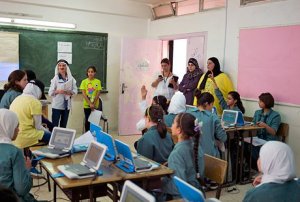The Science (and Practice) of Creativity
When schools nurture student creativity, they foster inquisitiveness, persistence, imagination, discipline, and collaboration, leading to improved classroom behavior, motivation, attendance, and academic attainment.
"Creativity isn't about music and art; it is an attitude to life, one that everybody needs," wrote the University of Winchester's Professor Guy Claxton in the lead-up to the 2014 World Innovation Summit for Education (WISE) dedicated to creativity and education. "It is a composite of habits of mind which include curiosity, skepticism, imagination, determination, craftsmanship, collaboration, and self-evaluation."
Sounds like the perfect skill set for equipping young people to navigate an increasingly complex and unpredictable world. Encouragingly, there's plenty of evidence -- from both research and practice -- that most of the above can be taught in the classroom. In fact, innovation and education experts agree that creativity can fit perfectly into any learning system.
But before it can be incorporated broadly in curriculum, it must first be understood.
Creativity Starts in the Brain
Recent research in cognitive science, often with education in mind, suggests that creativity is an ability that we all have and can cultivate with practice.
Complex cognitive mechanisms are required to produce creative ideas.
Dr. Ron A. Beghetto, co-creator of the Four C Model of Creativity (PDF, 332KB), says, "I have a real problem with 'thinking outside the box' because in reality we need to think creatively inside many boxes." In Explorations of Creativity: a Review for Educators and Policy Making (PDF, 5.6MB), Dr. Helen Abadzi explains that, in a nutshell, two sets of cerebral functions are involved in creativity. One is the ability to use our memory networks efficiently and rapidly, propelled by our ability to plan and execute. The other is the brain's resting state (mostly active when we are at rest or daydreaming) that helps us make unusual connections.
Creativity needs space and time to flourish at school.
Creativity doesn't come on demand. It also benefits from constraint. A subtle mix of pressure and time to come up with creative ideas is needed. School -- a "creativity-killing machine" -- can in fact become an opportune framework to set the required constraints and stretch the learners to face challenging tasks.
Nurturing Creativity at School
1. Memorization is a necessity.
Content matters, according to Dr. Abadzi. It's the fuel for future creative ideas. An education that fosters creativity should build automatized basic skills in reading, math, and reasoning. Educators must exercise the students' ability to retrieve and use knowledge in order to generate ideas, as unusual as they may seem, and to do so with sufficient speed to reach higher levels of complexity. This requires practice. So it matters to spend time on task and repetition until the mental operations become effortless (i.e. automatized). If you've learned to drive or play a musical instrument, you can easily relate to how much must be automatized in order to perform.
2. Enrichment experiences make flexible thinkers.
Exposure to different cultures, settings, languages, and other non-familiar experiences stimulate open-mindedness and hone divergent thinking abilities. Such experiences allow young minds to "change domains quickly and flexibly."

3. Creative problem solving should be promoted across all disciplines.
Children should be encouraged "to treat a task as a problem for which one invents an answer," said Jerome Bruner in his 1966 paper "The Growth of Mind." Fifty years on, the OECD recognizes the crucial importance of incorporating this skill into curricula: "All of life is problem solving."
And creative problem solving can be guided in just about any setting, as Prof. Claxton suggests:
In this talk, Dr. Beghetto offers further compelling examples for the classroom, like encouraging creative answers to math equations.
4. Recognize the power of persistence, focus, and so much more in creative endeavors.
Music and the arts get learners to discover new languages with new rules, opening them up to new forms of expression, leading them to observe and focus, and engaging their emotions -- an important factor in the learning process. In Australia, The Song Room project provides innovative, art-based workshops for schools serving the most disadvantaged children.
External evaluations show that participating in those workshops (for a minimum of six months) impacts the children's overall academic performance (including the ability to concentrate on tasks and to problem solve) as well as their school attendance (65 percent less absenteeism). It also improves their wellbeing, which reinforces their ability to learn.
5. Creativity fosters engagement in learning.
Creativity, Culture and Education (CCE), a U.K.-based organization, has developed an approach ensuring that pupils are challenged rather than directed, and that they are physically, emotionally, and socially engaged in the learning. In Lithuania, for example, they invited primary school pupils to listen to their local environment (at school and around the city) and take notes, inventing words to describe what they were perceiving. The intention was to help them hear the letters they were having difficulty learning in literacy class.
The approach was designed to operate within the existing curriculum, based on a language of creativity which teachers understand. And CCE's High-Functioning Classroom is used to train teachers around the world to engage their pupils in learning through creativity (like in these schools in Pakistan). The keys to creative habits of mind are:
- Inquisitiveness
- Persistence
- Imagination
- Discipline
- Collaboration
Forging these habits leads to evidenced improvements in classroom behavior, motivation, attendance, and academic attainment.
Reminder: Creativity and learning work hand in glove.
With the learners' self-esteem fueled and sense of agency encouraged, they are often eager to learn more as they realize how much they can do with what they know.
It's never too late to start.
Additional Resources
- The WISE Matters publications mentioned in this article also provide concrete recommendations for teachers, parents, and school leaders. Their executive summaries are available in additional languages (Arabic, Spanish, and French).
- Learn more about The Song Room.
- On motivation and creativity: Using MIT Media Lab's Scratch tool with Syrian refugee children.
- More discussions about creativity in education took place at WISE 2014, including empowering teachers, rethinking assessment, and addressing creativity at education-system level.
Editor’s Note: This post is inspired by one of the eight patterns appearing in educators’ innovative approaches in the Future of Learning report, “Equipping Adults to be Changemakers in Learning,” by Ashoka and the LEGO Foundation.
